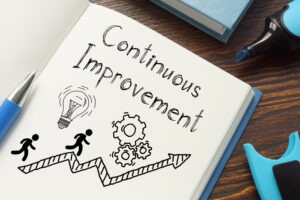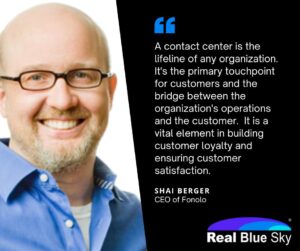The contact center is the primary hub of contact between your organization and your customers. Ken Blanchard is credited with reminding us to “Take care of your customers or someone else will.” It is critical that contact centers operate effectively to efficiently meet customer expectations. Continuous improvement is essential for customer operations to remain competitive in today’s fast-paced omnichannel environment, yet in practice, we see organizations are not applying a continuous improvement methodology more often than not.
Let’s explore the value of continuous improvement in the contact center and provide practical tips for improving your customer operations.

Challenges in the Contact Center Today
Contact centers face a variety of challenges that make it difficult to deliver consistently high-quality customer experiences.
Growing Contact Volumes and Increasingly Complex Interactions

One of the biggest challenges is high contact volume. It leads to long hold times, frustrated customers, and overwhelmed agents. Customer interactions are also becoming increasingly complex, partly because of self-service containment. At the same time, customers expect to seamlessly interact with your brand across multiple channels, like email, social media, chat, and voice. For example, customers expect to transition multiple channels of communication, such as from Facebook Messenger to a phone call, without the need to repeat their concerns. Without a robust strategy for omnichannel support, customers suffer a fragmented and poor experience.
Technology Challenges
 With the ever-increasing advancement of conversational intelligence, AI, chatbots, RPA (robotic process automation), and so many more technologies in the contact center, customer expectations themselves are growing at a hurtling rate. These tools promise to deliver tremendous improvements in both agent and customer experiences, all while enhancing efficiency. However, deploying these technologies presents its own set of challenges, not least of which include managing costs, agent and customer resistance to change, limited expertise, and risks related to data silos, regulatory compliance and interoperability.
With the ever-increasing advancement of conversational intelligence, AI, chatbots, RPA (robotic process automation), and so many more technologies in the contact center, customer expectations themselves are growing at a hurtling rate. These tools promise to deliver tremendous improvements in both agent and customer experiences, all while enhancing efficiency. However, deploying these technologies presents its own set of challenges, not least of which include managing costs, agent and customer resistance to change, limited expertise, and risks related to data silos, regulatory compliance and interoperability.
Regulatory Compliance
As a business function alone, customer operations must follow an extensive set of federal, state, and international regulations, such as the TCPA, various FTC rules, and state rules. Add to this the growing patchwork of customer data privacy regulations, from GDPR and CCPA/CPRA to the growing mix of additional state regulations. This list does not even touch on the industry-specific regulations your organization is subject.
Pro Tip: Make sure to provide the same level of service to ALL your customers. If, for example, you are supporting customers in California, you already have to comply with CPRA. Also provide the options to customers not residing in California that you’re already required to provide California residents (or the highest regulatory level of service).
Language and Localization
 Providing in-language support in contact centers can be a significant challenge, particularly for organizations that operate in diverse and multicultural environments. Language barriers can lead to miscommunication, frustration, and customer dissatisfaction. Some self-service options and policies may not localize well, leading to unique continuous improvement opportunities.
Providing in-language support in contact centers can be a significant challenge, particularly for organizations that operate in diverse and multicultural environments. Language barriers can lead to miscommunication, frustration, and customer dissatisfaction. Some self-service options and policies may not localize well, leading to unique continuous improvement opportunities.
The Continuous Improvement Framework
 But how do you manage all the complexity of your contact center’s operations? Enter the continuous improvement framework.
But how do you manage all the complexity of your contact center’s operations? Enter the continuous improvement framework.
The continuous improvement framework is a systematic approach organizations use to continually enhance their processes, products, and services. It is a cyclical process that involves identifying the most impactful areas for improvement, analyzing data to uncover root causes, developing and implementing solutions, and monitoring progress to ensure improved, or at least sustained, results. This framework – designed to foster a culture of continuous learning and innovation, aiming to increase efficiency, quality, and customer satisfaction – has its origins in the defect management approach for manufacturing we find in Six Sigma
The Continuous Improvement Framework in the Contact Center
The framework involves the regular monitoring and evaluation of key performance metrics, such as contact resolution times, first contact resolution rates, and customer satisfaction or net promoter scores (NPS), to identify areas for improvement. Focusing on defects, like non-resolution, dissatisfaction, and detractor/neutral scores, based on this data, organizations can implement targeted improvements, like agent training, process optimization, policy changes, or technology improvements, and then monitor the impact of these changes.
Applying the Continuous Improvement Framework in the Contact Center
To apply the continuous improvement framework, it’s important to follow a structured, multi-step approach. Of great importance is the ability to bring disparate data together. Being able to bring together call detail records (CDR), CSat, NPS, customer friction and resolution data, Customer Relationship Management (CRM) and/or Order Management System (OMS) or other relevant systems, in such a way that analytics or business intelligence (BI) tools can help identify correlations between them is vital to uncovering what may be the underlying cause of service “defects.”
Bringing this data together may help you identify that certain contact types have lower customer satisfaction, a greater negative impact to NPS, and also result in multiple callbacks and longer handle times. Such information may lead to finding the need for a specific process improvement, which may improve the customer experience.
In a nutshell, the continuous improvement cycle follows these steps:
- Decide: Find the most critical needs for improvement. This may be a cost metric (e.g. adjustments, high handle times), a customer metric (e.g. NPS), or something else. For example, let’s say your customer satisfaction is 87% (meaning 13% dissatisfaction), and that improving this is your most critical need.
- Prioritize: Using your data, identify the most impactful incidents correlated to your critical needs; these are your “drivers.” This may be a specific call type, a particular team, etc. The Pareto Principle – from which we get the “80/20 rule” – is important here. Continuing with our example, you may identify that shipping delays are the call types that result in the highest number of dissatisfied customers and represent 5% of the 13% dissatisfaction. Eliminating this “defect” would then potentially have the greatest effect on improving customer satisfaction (up to 500 bps). Select no more than two or three.
- Solve: Once you have selected two or three of the greatest drivers, it’s now time to dig into what is happening that drives the defects; this will be our root cause analysis. Continuing our example, you may further analyze the data to identify that most of the shipping delays are for items shipping from a particular fulfillment center. This may lead to collaborating with that fulfillment center on what may be causing the delays – perhaps a process or policy, for example.
- Design: Now that you have found the root cause of your drivers of critical improvement needs, you’re now poised to identify an improvement to solve for the defect. This is a great exercise the team can rally behind.
- Implement: With solutions to your root causes developed, it is now time to implement. This may require retraining, retooling, or even a (hopefully small) IT project to deploy, so allow time, as needed. Importantly, allow time for a sufficient sample of contact types to occur using the new process. We typically see this in 2-4 weeks, depending upon the volume of contacts your center handles.
- Measure: Now measure the results! Following our example, we may find that shipping delays have now been reduced from 5% to only 2% of total dissatisfaction. That’s a huge win! You’re now ready to start the cycle over (they do call it continuous improvement for a reason).
Following our example, you may find yourself saying, “Wait a minute! Shipping delays accounted for 5% of dissatisfaction. Why did we only get a 3% lift?” That’s a great question! The reality is that there are many factors which may be involved. It may be that our assumptions about what would solve the fulfillment center process were incomplete. Or some of those cases of dissatisfied customers also had a secondary driver. It is also possible a new driver has emerged. The bottom line is that it’s perfectly normal not to fully eliminate the defect rate. You may even find the “solution” put in place did not have the desired effect on the improvement need.
Pro Tip: Identify those things that are going well, too. And recognize those on your team who are executing well.
Based on the findings, leaders can identify opportunities for improvement and implement targeted solutions, such as training, process optimization, or technology enhancements. To ensure improvements are sustained over time, ongoing monitoring and evaluation must be done to track progress and identify potential opportunities.
Pro Tip: When we found that a dissatisfaction driver was consistent across all agents, it tended to be problems with policy, process, and training. When it was with just certain individuals, we identified that possibly people were using different policies or versions, or they were executing differently, perhaps because of a knowledgebase or training need.
Implementing Improvement Strategies
For many of the organizations we work with, we find a 6–8-week improvement sprint cycle is the time it takes to identify the top drivers, perform root cause analyses, develop a solution, allow time for that solution to “bake,” and measure the results.
This iterative process helps identify the most impactful changes and enables contact centers to drive ongoing improvement over time. By focusing on no more than three key areas of improvement at a time and implementing changes in a structured way, your customer operations can drive significant improvements in efficiency, customer satisfaction, and business growth.
Challenges in Implementing Continuous Improvement
You may see now how implementing continuous improvement is essential for driving better customer experiences and increasing efficiency. However, it’s not without its challenges. One of the main obstacles is the resistance to change from agents and customers alike. Agents may be reluctant to adopt new technology or processes, and customers may prefer human interactions over automated ones.
Further, introducing new processes or policies may require specialized support, such as from Training or Technology, which may lack capacity to support the desired change. Another challenge is the need for effective communication and collaboration across silos to identify and address causes of friction in the customer journey. Overcoming these challenges requires a structured approach to implementing continuous improvement, with clear goals, metrics, and processes in place to ensure success.
Conclusion
Contact centers play a vital role in growing your brand’s relationship with its customers, and continuous improvement is essential to remain competitive. The challenges faced in customer contact are significant, as we have only partially covered here.
Adopting a continuous improvement framework that includes regularly monitoring and evaluating performance metrics can help customer operations streamline processes, reduce costs, and improve customer experiences. Using data, adopting appropriate tools, and ensuring effective collaboration across teams positions you to optimize your operations and enhance the skills of your team. Ultimately, this leads to higher customer satisfaction, loyalty, revenue, and profitability.
Need help improving your customer operations? Schedule a conversation. Also see our posts on contact center operations, “Should You Outsource Your Contact Center?” and “Ongoing Training is Critical in the Contact Center.”


